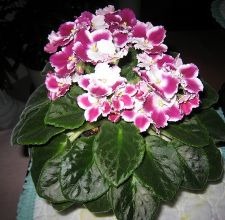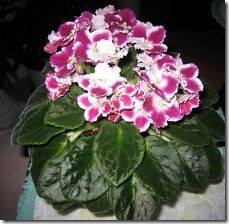All green plants need light. The type and amount supplied to your African violet will determine whether or not the plant will grow to be healthy and attractive. There are two light types: natural and artificial. Both can be used with excellent results. After reading this article, you will be able to find just the right place in your home to provide optimal light for your African violet.
- Difficulty:
- Moderately Easy
Instructions
things you’ll need:
- African violet
- Natural light
- Fluorescent or incandescent light
- Plant stand
- The light that created this shadow is too bright for an African violet. PAfrican violets need light, but never the direct light of the sun. Do you have a window that faces east, northeast or northwest? I have had the best results with African violets placed near those windows. How can you determine whether or not the light is too bright? A good rule of thumb is: if the light creates a well-defined, dark shadow, it is too bright for an African violet.
- This light is just right for an African violet.
Do you have only a bright southern exposure? Install a sheer curtain, blinds, or other light diffuser on the window.
 Sheer curtains diffuse light. Photo courtesy Shirley Lai/PhotoXpress
Sheer curtains diffuse light. Photo courtesy Shirley Lai/PhotoXpress-
Now that you have selected the general vicinity, where should the plant be placed? Keep the African violet away from drafts and about a foot away from the window. In most cases, this eliminates the window sill as a place for your African violet. Never allow the leaves to come into contact with the glass, because they can be damaged. Before the colder months arrive, check this window for drafts and seal any that you find.
 Mini blinds can be used to diffuse light, but this plant is too close to the window!
Mini blinds can be used to diffuse light, but this plant is too close to the window!-
Select a plant stand that puts the base of the African violet pot level with the window sill. If the stand is too low, the plant will develop a "leggy" look as its leaves try to reach the light.
- Turn the African violet regularly. An easy way to do this is to turn the plant 90 degrees clockwise each time you water it. All sides will receive equal exposure to light over time, and the plant will grow symmetrically. Of course, to get the very best result, turn your African violet a quarter turn every morning. My grandmother had a multi-shelf plant holder that was as broad as the window and filled with African violets, which she turned each morning without fail. They were gorgeous!
- If you water your African violet from the top and happen to get a few drops on the leaves, blot with a paper towel and keep the plant away from light until the leaf is completely dry. Otherwise, the leaves will develop unattractive brown spots: think of it like sunburn. See "How to Water an African Violet" for more information.
- Optimally, African violets daily need about 12 to 14 hours of light to continue to grow and bloom. You could use a grow light or fluorescent light about a foot directly above the plant to supplement daylight hours, but that’s not a look I want for my home. For years, I’ve simply used a table lamp with a regular incandescent bulb to provide light during fall and winter evenings, and my plants flower year-round.
Tips & Warnings
-
If the color of the leaves turns yellowish-white, the African violet is receiving too much light. Move it further away from the window or physically block some of the light, such as by keeping the blinds mostly closed.
-
If you use a grow light, follow the package directions for proximity and length of use.
-
Don’t expose your African violet to more than 14 hours of light. Ten hours of darkness are a necessary part of the light cycle.


Deprecated: strpos(): Passing null to parameter #1 ($haystack) of type string is deprecated in /home/agriviek8Qv/agriviet.net/public_html/wp-includes/comment-template.php on line 2522